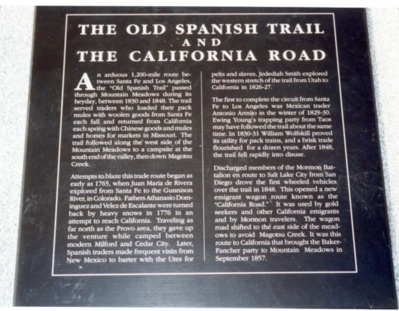Utah’s Spanish and Mexican Communities
Utah has a long history of Latino communities. The first Spanish explorer to arrive in Utah was possibly Captain Garci-Lopez de Cardenas, who traveled through the Southwest in 1541. In 1765, Juan Maria Antonio de Rivera wanted to live near the Colorado River to learn about the Native Americans who lived there. Many Spanish explorers and Latino people traveled through and lived in Utah before it became a territory of the United States. Spanish explorers recorded information about Utah’s Indigenous peoples, the terrain, and natural resources as they traveled through. They renamed trails and other landmarks, and their presence is an important part of Utah’s history.

Several push and pull factors brought Spanish conquistadors to North, South, and Central America, including Utah. Conquistadors left Spain hoping to get more land and natural resources to increase their wealth. Land, natural resources, and trading opportunities pulled Spanish explorers to Utah.
In 1776, the expedition led by Silvestre Vélez de Escalante and Francisco Atanasio Dominguez traveled from Santa Fe to Utah. Spanish traders went to Utah to trade with and try to convert the Navajo and Ute people who lived there. As with other European expeditions, Native Americans guided and served as interpreters for the group. Later, people studied their writings to establish the Old Spanish Trail, which started in Santa Fe, went North to southern Utah, and ended in California. During the 1800s, Americans and immigrants followed the Spanish trail to settle in Utah.
Utah was a part of the Spanish Empire from the late 1500s until 1821 when Mexico won its independence from Spain. While no Spanish settlers are recorded to have settled in Utah, the region was well-traveled by traders on the Santa Fe—or Spanish—Trail. From 1829 to 1848, many wagon trains and other travelers passed through southern Utah. These
caravans traveled between Santa Fe, New Mexico, and Los Angeles, California.
Many Anglo fur trappers arrived in Utah between 1820 and 1840. They trapped animals throughout the southwest and sold their pelts at different trading posts. Mexican cities, like Taos, served fur trappers and other traders. Animal pelts were not the only commodity traded in the southwest. Many people traded and sold enslaved Native Americans along the Santa Fe Trail. Some American fur trappers hunted on Mexican territory without permission from the Mexican government. They smuggled goods across the border and hunted animals, like beaver, without permission. Other trappers became Mexican citizens. Antoine Robidoux built the first trading post located in Utah named Fort Uintah. Fort Uintah was at the junction of Uintah River and White Rocks Creek. While not many Spanish and Mexican residents and citizens traveled, traded, or lived in Utah before the 1900s, those who did shaped the way that people understood and identified with the area.
From 1846 to 1848, the United States of America fought against Mexico in the Mexican American War. The war ended when the United States and Mexico signed the Treaty of Guadalupe Hidalgo. Mexico lost its northern territory that includes what is now Utah, Nevada, California, New Mexico, and Colorado. Suddenly, the Mexican citizens who lived in
the Southwest became American citizens. The war ended when the United States and Mexico signed the Treaty of Guadalupe Hidalgo. The treaty, among other things, designated Utah, Nevada, California, Arizona, New Mexico, and part of Colorado as United States territory.
Today, we can see traces of Spanish influence on Utah’s landscapes. Utah’s modern highways follow the Spanish trail route. We can see Spanish influence in Southern Utah in place names such as the San Juan and San Rafael rivers and the LaSal Mountains. Of course, Latinos continued to build communities in Utah after it became a United States territory. Their experiences were different once they were considered part of America, and their history is an important part of Utah’s story.